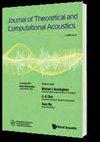Laser-Assisted Reconstruction of Vibro-Acoustic Behaviors of an Arbitrarily Shaped Vibrating Structure
IF 1
3区 物理与天体物理
Q3 ACOUSTICS
Journal of Theoretical and Computational Acoustics
Pub Date : 2020-09-01
DOI:10.1142/S2591728519500117
引用次数: 1
Abstract
This paper presents a new method known as laser-assisted, modified Helmholtz Equation Least Squares method-based reconstruction to determine vibro-acoustic quantities of an arbitrarily shaped vibrating structure subject to a noncontact acoustic excitation. Unlike the traditional near-field acoustical holography (NAH) that relies on the acoustic pressures measured in the near-field, this new methodology enables one to collect the input data at a remote distance by using a laser vibrometer, making measurement setup much easier than all previous NAH approaches. Most importantly, by measuring the normal components of the surface velocities at the accessible areas, one can acquire near-field information of a vibrating structure directly, rather than indirectly through reconstruction based on the acoustic pressures measured in the near field. To ensure the accuracy in reconstruction of all the vibro-acoustic characteristics of a structure, the acoustic pressures at a few points in space are also measured. By combining these partial input data, one can acquire a complete picture of the vibro-acoustic field of an arbitrarily shaped vibrating structure, which includes operation deflection shapes, distributions of the acoustic pressures and the normal component of the acoustic intensities on a source surface, and the time-averaged acoustic power of the structure. When the input power is specified, one may determine the frequency response functions, the natural modes, the structural damping ratios of the structure, sound transmission loss, sound transmission path, etc. Examples of using this technology to acquire an in-depth understanding of the vibro-acoustic characteristics of an automobile front dash panel are presented.任意形状振动结构的振动声特性激光辅助重建
本文提出了一种基于激光辅助的修正亥姆霍兹方程最小二乘法重建的新方法,用于确定非接触声激励下任意形状振动结构的振声量。与传统的依赖于近场声压测量的近场声学全息(NAH)不同,这种新方法可以通过使用激光测振仪在远程收集输入数据,使测量设置比以前的所有NAH方法更容易。最重要的是,通过测量可达区域表面速度的法向分量,可以直接获得振动结构的近场信息,而不是通过基于近场测量的声压进行间接重建。为了保证结构振声特性重建的准确性,还测量了空间中几个点的声压。结合这些部分输入数据,可以获得任意形状振动结构的振动声场的完整图像,包括工作挠度形状,声压分布和声强在源表面的法向分量,以及结构的时间平均声功率。当输入功率确定后,可以确定结构的频响函数、固有模态、结构阻尼比、传声损失、传声路径等。给出了使用该技术深入了解汽车前仪表板振动声学特性的实例。
本文章由计算机程序翻译,如有差异,请以英文原文为准。
求助全文
约1分钟内获得全文
求助全文
来源期刊

Journal of Theoretical and Computational Acoustics
Computer Science-Computer Science Applications
CiteScore
2.90
自引率
42.10%
发文量
26
期刊介绍:
The aim of this journal is to provide an international forum for the dissemination of the state-of-the-art information in the field of Computational Acoustics.
Topics covered by this journal include research and tutorial contributions in OCEAN ACOUSTICS (a subject of active research in relation with sonar detection and the design of noiseless ships), SEISMO-ACOUSTICS (of concern to earthquake science and engineering, and also to those doing underground prospection like searching for petroleum), AEROACOUSTICS (which includes the analysis of noise created by aircraft), COMPUTATIONAL METHODS, and SUPERCOMPUTING. In addition to the traditional issues and problems in computational methods, the journal also considers theoretical research acoustics papers which lead to large-scale scientific computations.
 求助内容:
求助内容: 应助结果提醒方式:
应助结果提醒方式:


